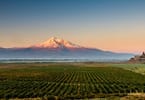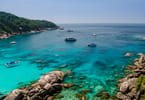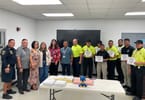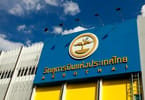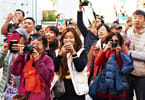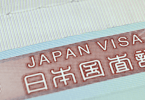(eTN) – On the days immediately before, during and after the first anniversary of the March 11 , 2011 earthquake and tsunami, Japan engaged in days of soul-searching and reflection on the events of the calamitous day that killed 20,000 Japanese people. Japanese TV reminded viewers of the horror of those days and the impact on individuals, families and communities For the Japanese tourism industry, recovery has been complicated by the false perception that the extensive damage caused to the Fukushima Nuclear Power Station has irradiated large swathes of Japan.
The damage to Japan’s tourism industry is reflected by the significant downturn in the number of international arrivals–In 2010, Japan welcomed over 8.6 million international arrivals and in 2011, the total international arrivals dropped by 28 percent to just over 6.2 million arrivals. The cost to Japan’s economy and especially its international inbound tourism industry is estimated to be about US$6 billion.
The Japanese tourism industry has undertaken a major campaign to try and restore international visitation and confidence in Japan. The primary challenge is to overcome the damaging but false perception that all or most of Japan is under radioactive cloud. Certainly the tsunami’s damage to the Fukushima Nuclear Power Plant in the Sendai Prefecture (150 kms north of Tokyo) did result in radioactive leakage that impacted most heavily an area within about 25 kms of the plant (which is still under an exclusion zone). The appalling miscommunication of the damage to the power plant by the Tokyo Electronic Company (TEPCO) and the Japanese government emitted waves of distrust and speculation far more damaging than the radioactivity emitted from the damaged power station.
I was invited by the prefectural government of Okinawa and the Japan Tourism Board to be the keynote speaker at a tourism crisis management conference, held in the prefectural capital Naha on March 12, 2012, to mark the first anniversary of the Japan earthquake and tsunami. Okinawa, which is the southern extremity of the Japanese chain of islands, is a three-hour flight (1,500 kms ) south of Tokyo and is the main island in a cluster of 200 islands, of which about 60 are inhabited. Being on the same latitude as Hawaii, Okinawa shares Hawaii’s warm subtropical climate, dramatic scenery and is a popular tourist destination for Japanese. In fact, it even has its own Okinawan version of “Aloha” shirts which is worn by all classes of people–from the governor to working people. Six million Japanese visit Okinawa each year, but attracts only 300,000 foreign visitors per annum. The many and varied charms of Okinawa are something of a secret to the rest of the world. Having now had some experience in Okinawa, I found it to one of the most inspiring places I have ever visited. It has a very distinctive culture and history that sets it apart from the rest of Japan.
Okinawa has a wide-range of fine hotels and resorts. During my visit, I was shown the comprehensive range of protective measures that the local tourism and hospitality industry have taken to shield their guests from earthquakes, typhoons and tsunamis. Every hotel room in Okinawa has a colouful manual in Japanese, English, Chinese and Korean explaining possible risks and measure to deal with them. Many of the newer coastal resorts have accommodation built on higher ground and a shuttle service to the seashore. Older seaside resorts restrict guest accommodation to above ground floors. Most have well-developed alarm, rescue and evacuation procedures in the event of natural disasters. In Okinawa, attractions, hotels, inter-island cruises and resorts consistently demonstrate world’s best practice in guest safety and risk readiness.
The prefectural government tourism authority and the tourism industry take the issue of risk management seriously. Okinawa Prefectural Governor Hirokazu Nakaima told me and a small group of Okinawa tourism leaders that the safety of tourists and the tourism industry’s preparedness of tourism infrastructure and businesses for natural disasters was the top priority for his government. It was certainly clear that these words were being matched by action. Among tourism industry professionals in Okinawa crisis management and risk readiness is practiced with fervent commitment.
The Okinawa Tourism Crisis Management Conference, held at the Naha Convention Centre on March 12, 2012, was attended by over 130 tourism industry and government leaders and was widely-covered by national TV and local media. Tourism safety and post-tsunami tourism recovery is a matter of intense public interest in Japan in general, but especially among Okinawa’s 2 million people as it is the prefecture’s main industry. Mr. Masato Takamatsu and his team from Japan Marketing Company have been commissioned to develop a crisis management manual for the entire Okinawa tourism industry and the conference was a part of that strategy for crisis preparedness. Certainly, communicating the very simple message that most regions of Japan including Okinawa are safe and secure for tourism is an integral part of Japan’s tourism recovery strategy. My presentation focused on the issue of crisis and recovery communication.
The Okinawa conference served as a precursor to the Global Tourism Summit, which being organized by the World Travel and Tourism Council in association with the UN World Tourism Organization and Pacific Asia Travel Association in Sendai and Tokyo starting on April 16. The summit will include extensive focus on tourism risk and crisis management issues, especially as they affect Japan.
The author is a senior lecturer in tourism at the University of Technology in Sydney. He is the co-author with Bert van Walbeek of “Bounce Back: Tourism Risk Crisis and Recovery Management Guide” to be published by the Pacific Asia Travel Association and launched in Japan next month at the WTTC Global Tourism Summit. The publication will be released in English, Japanese and Chinese language versions.
WHAT TO TAKE AWAY FROM THIS ARTICLE:
- I was invited by the prefectural government of Okinawa and the Japan Tourism Board to be the keynote speaker at a tourism crisis management conference, held in the prefectural capital Naha on March 12, 2012, to mark the first anniversary of the Japan earthquake and tsunami.
- Okinawa, which is the southern extremity of the Japanese chain of islands, is a three-hour flight (1,500 kms ) south of Tokyo and is the main island in a cluster of 200 islands, of which about 60 are inhabited.
- Japanese TV reminded viewers of the horror of those days and the impact on individuals, families and communities For the Japanese tourism industry, recovery has been complicated by the false perception that the extensive damage caused to the Fukushima Nuclear Power Station has irradiated large swathes of Japan.






